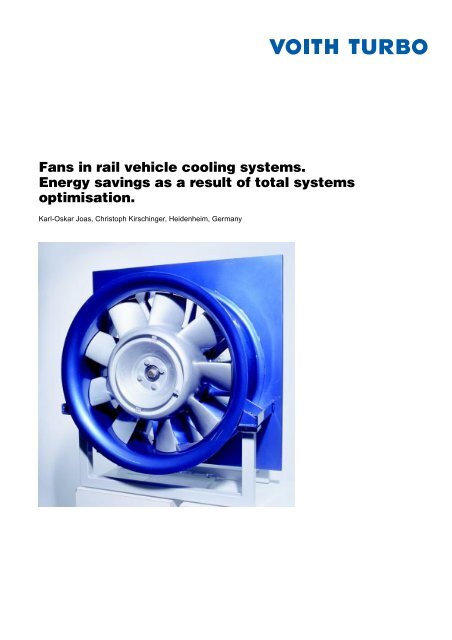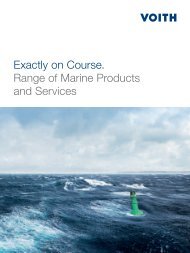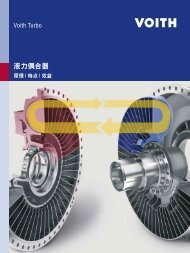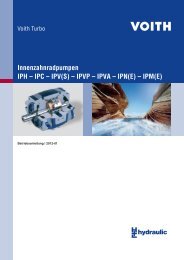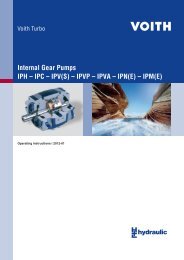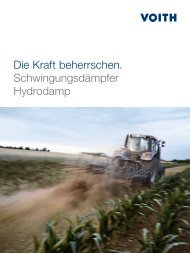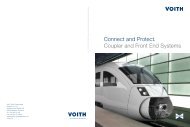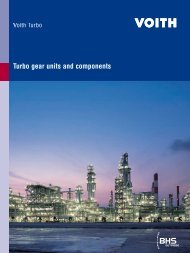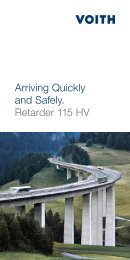Download PDF - Voith Turbo
Download PDF - Voith Turbo
Download PDF - Voith Turbo
Create successful ePaper yourself
Turn your PDF publications into a flip-book with our unique Google optimized e-Paper software.
Fans in rail vehicle cooling systems.<br />
Energy savings as a result of total systems<br />
optimisation.<br />
Karl-Oskar Joas, Christoph Kirschinger, Heidenheim, Germany<br />
1
2<br />
Contents<br />
1. Introduction 3<br />
2. History and technical development 3<br />
3. Operation of cooling system fans 6<br />
3.1 Drive and control 7<br />
3.1.1 Mechanical / hydrodynamic drive 7<br />
3.1.2 Hydrostatic drive 8<br />
3.1.3 Electrical drive 10<br />
3.2 Design and rating of the radiator 10<br />
3.3 Cooling air demand, flow resistances, and safety margins 12<br />
3.4 Arrangement of the fan 13<br />
3.5 Fan operating points 14<br />
3.6 Noise emission and sound insulation 15<br />
4. Modern cooling systems and their design 16<br />
5. Economical considerations 17<br />
6. Summary 18<br />
References 18
Summary<br />
Fans are a key component in rail vehicle<br />
cooling system. This fact has been recognised<br />
by <strong>Voith</strong> <strong>Turbo</strong> GmbH & Co. KG,<br />
Heidenheim, who consequently developed<br />
a special range of cooling fans.<br />
All fans from this range have modular<br />
design and can be adapted to any application.<br />
They ensure that cooling systems<br />
run with maximum efficiency, offering<br />
the customer excellent benefits.<br />
The concept of a cooling system is determined<br />
by the synergies between the<br />
fan, the heat exchangers, the prevailing<br />
operating conditions and the<br />
driveline designs of individual rail vehicle<br />
types, as well as by the way in which<br />
they are installed. Intelligent arrangements<br />
of the components and optimum<br />
aerodynamic designs result in high<br />
efficiencies of the fans and fan drives.<br />
Initial investment costs for aerodynamic<br />
layout schemes and higher purchasing<br />
costs for high-quality components pay<br />
off within just a few years.<br />
1. Introduction<br />
The increasing use of diesel engines<br />
by railway operators since the 50s created<br />
a high demand for powerful rail vehicle<br />
cooling systems and thus also for<br />
high-quality fans. A wide range of fans<br />
evolved and was systematically improved<br />
and adapted to the requirements<br />
and installation characteristics of<br />
the components to be cooled.<br />
Fans are driven by auxiliary energy and<br />
are used for dissipating waste heat from<br />
power-transmitting machines. The<br />
smaller the required amount of auxiliary<br />
energy for the same quantity of dissipated<br />
heat, the more economical the<br />
overall system.<br />
For best results it is important to examine<br />
the entire aerodynamic system with<br />
all the parts exposed to the air flow and<br />
not just the fan alone. Intelligent speed<br />
control is a prerequisite of a favourable<br />
energy balance, too. And finally, aspects<br />
such as cost, environmental conditions,<br />
noise emission, and reliability<br />
must be taken into account.<br />
From this point of view, the main task<br />
for project engineers of cooler manufacturers<br />
is to optimally match the various<br />
components necessary for overall<br />
performance of the aerodynamic part<br />
of the cooling system to each other.<br />
A high knowledge of the technical conditions<br />
in the vehicle and several iteration<br />
steps when planning the aerodynamic<br />
system are required for this,<br />
since it is obviously impossible to create<br />
optimum operating conditions for all<br />
the components at the same time due<br />
to the prevailing boundary conditions<br />
and the available space. A compromise<br />
made for the design of one of the components<br />
often has a positive influence<br />
on overall efficiency.<br />
3
2. History and technical development<br />
The development of axial-flow fans by<br />
<strong>Voith</strong> <strong>Turbo</strong>, Heidenheim, began in 1930,<br />
i. e. at the same time as the first turbo<br />
transmissions were developed, with<br />
research work by Marcinowski [1 to 3].<br />
As early as 1932, <strong>Voith</strong> supplied a large<br />
impeller for an axial-flow fan in a wind<br />
tunnel. In the following years, development<br />
concentrated on different impeller<br />
blades and vanes. The different designs<br />
formed a modular system that permitted<br />
fans to be adapted to different operating<br />
conditions in a highly flexible<br />
way.<br />
Later, the development of axial-flow<br />
fans was supplemented by that of radial-flow<br />
and cross-flow fans leading to<br />
wind turbines and a multi-stage axial<br />
compressor for research purposes.<br />
This opened up a wide range of possible<br />
applications for our fans:<br />
- stationary applications in paper<br />
machines,<br />
- large-scale building ventilation,<br />
-fans for underground mining,<br />
- tunnel ventilation using fixed or<br />
variable-pitch blades,<br />
-fans in power stations, especially for<br />
flue gas desulphurization plants and<br />
wind tunnels,<br />
-fans in vehicles, especially as a part<br />
of <strong>Voith</strong> cooling systems for rail<br />
vehicles, and in snow guns.<br />
4<br />
The versatile and comprehensive<br />
modular system developed by<br />
Marcinowski for axial-flow fans can be<br />
used for both directions of rotation in<br />
the following configurations:<br />
- impeller with cap suitable for both<br />
flow directions,<br />
- same impeller as above, yet with<br />
guide vanes for certain blade<br />
designs,<br />
- impeller with guide vanes (mainly<br />
on downstream side) and downstream<br />
centre fairing for certain<br />
blade designs,<br />
- impeller with guide vanes (mainly<br />
on downstream side) and external<br />
diffuser, and<br />
- special versions derived from the<br />
above.<br />
The types of blading and blade designs<br />
for different pressure stages are divided<br />
into basic groups with defined hub/tip<br />
ratios ν (ν = hub dia. / impeller blade tip<br />
dia., table 1):<br />
Type<br />
Hub/tip ratio<br />
d<br />
ν =<br />
D<br />
d<br />
D<br />
∆p t = max. total pressure<br />
difference<br />
in Pa<br />
Distributor<br />
without with<br />
N 0.315 ≈ 1000 –<br />
M 0.5 ≈ 1500 ≈ 2000<br />
H 0.63 ≈ 2000 ≈ 2500<br />
Table 1: Hub/tip ratio and total pressure difference for certain types in<br />
the range of standardized hub/tip ratios:<br />
0,28 / 0,315 / 0,355 / 0,4 / 0,45 / 0,5 / 0,56 / 0,63 / 0,71<br />
• The size ranges of hub and tip<br />
diameter are based on the R 20<br />
series of preferred numbers as per<br />
DIN 323.<br />
• The number of blades and their<br />
angle of attack can be varied as<br />
required (even for cast impellers<br />
thanks to the modular system). The<br />
same applies to the guide vanes.<br />
•For the sake of simplicity the<br />
principle of stating specific power<br />
via flow coefficient ϕ and pressure<br />
coefficient ψ has been transformed<br />
into a work sheet (fig. 1) with fulllogarithmic<br />
coordinate system<br />
showing a family of straight lines for<br />
- outer impeller diameter and<br />
- speed (together with the resulting<br />
tip speed).<br />
• The work sheet (fig. 1) shows the<br />
relation between the specific energy<br />
Y (flow resistance ∆ρ referred to<br />
an air density of ρ = 1 kg/m3 ) and<br />
•<br />
the volume flow VL for one type of<br />
impeller and one hub/tip ratio.<br />
Characteristic ranges found during<br />
tests are used for the various hub/<br />
tip ratios. Size, design, and further<br />
technical features of a fan with a
specified working point (L in fig. 1)<br />
can be defined with the aid of the<br />
work sheet and further dimensionless<br />
characteristic diagrams (not<br />
shown here) for various fans differing<br />
from each other in the abovementioned<br />
features by superposing<br />
the two graphs.<br />
The modular system developed by<br />
Marcinowski was thus supplemented<br />
by a tool for selecting the best fan for<br />
a given application.<br />
The influence of the number of blades<br />
and the impeller clearance gap on fan<br />
characteristics and noise emission<br />
[1, 2] were measured as well. The clearance<br />
gap depends exclusively on the<br />
accuracy of manufacture of impeller<br />
and shroud.<br />
For rail vehicle applications, characteristic<br />
diagrams were prepared that take<br />
into account the arrangement of the<br />
fans and the flow behaviour under the<br />
different geometric conditions that prevail<br />
in such vehicles. These empirical<br />
findings were taken as a basis for the<br />
proprietary software programs used for<br />
calculating flow loss in cooling systems.<br />
In view of increasingly stringent demands<br />
made on cooling systems and<br />
new developments in the field of radiator<br />
elements, the fan system was further<br />
perfected with the aim of achieving<br />
a highly uniform flow velocity in the<br />
annular surface of the fan while increasing<br />
efficiency for common working<br />
points. The result were two new blade<br />
designs, one for an impeller without<br />
guide vanes and one for an impeller<br />
with outlet vanes.<br />
These new blade designs permit deviations<br />
from the standard outer diameters,<br />
allowing higher flexibility of adaptation<br />
to different installation conditions.<br />
Other benefits include a further<br />
optimization of the fan design and adaptation<br />
to the fan drive used.<br />
Y in Nm/kg<br />
Speed n in 1/min<br />
D in mm<br />
2000<br />
1800<br />
1600<br />
1400<br />
1200<br />
B<br />
D = 710<br />
3500<br />
D = 800<br />
3000<br />
2850<br />
2400<br />
1000<br />
VL in m3 5 6 7<br />
/s<br />
8 9 10<br />
L<br />
D = 900<br />
2600<br />
2000<br />
1800<br />
D = 1000<br />
2200<br />
Fig. 1: Detail of work sheet for determining fan diameter, fan speed,<br />
and fan type.<br />
B = Example of a reference point for superposition with the<br />
characteristic range of a fan. The non-dimensional<br />
characteristic diagram of a fan (not shown) is applied at<br />
the reference points. The aim is to select a fan type<br />
whose performance curve contains a specific<br />
performance point L.<br />
L = Example of a performance point for which a fan characteristic<br />
is sought.<br />
Tests have been made at the <strong>Voith</strong><br />
Aerodynamics Test Centre to examine<br />
the air flow in cooling systems of rail<br />
vehicles in tunnels. The effects of different<br />
vehicle front end designs on air<br />
flow around the vehicles were also<br />
tested at different speeds. The arrangement<br />
of air inlets and outlets was<br />
optimized in tests, and pressures were<br />
measured so that they could be taken<br />
into account for fan design. For special<br />
applications these findings help deciding<br />
on the power reserves to be provided<br />
[3].<br />
5
3. Operation of cooling system fans<br />
Fan design depends on the following<br />
factors:<br />
- the type of vehicle and thus the type<br />
and arrangement of the cooling<br />
system in the vehicle,<br />
- the nature of the components to be<br />
cooled and the type of coolant,<br />
- the type of drive and control of the<br />
fan and cooler group,<br />
- the operating mode and design of<br />
heat exchangers, and<br />
- the total flow loss of the system.<br />
It has become apparent over time that<br />
certain arrangements, cooling system<br />
types, and fan drives should be preferred<br />
depending on vehicle type.<br />
6<br />
Fig. 2: Axial flow fan<br />
For locomotives, the cooler group can<br />
usually be arranged next to the component<br />
to be cooled. For railcars and<br />
trainsets with underfloor powerpacks a<br />
greater distance may be necessary or<br />
the cooler group may have to be arranged<br />
under the roof of the vehicle.<br />
Sometimes, the axial-flow fans (fig. 2)<br />
mostly used in cooling systems are replaced<br />
by radial-flow fans today if the<br />
installation conditions and ratings are<br />
favourable and noise is to be minimized.<br />
In the majority of cases, however, axialflow<br />
fans are adequate for the total<br />
pressure loss mostly found today.<br />
Moreover, axial-flow fans can be easily<br />
adapted to the required cooling air<br />
flows. With radial-flow fans, in contrast,<br />
the possible pressure head cannot be<br />
utilized. Cooling air flow is limited due<br />
to the limited intake velocity of air in the<br />
∆ptot in Pa<br />
600<br />
500<br />
400<br />
300<br />
200<br />
100<br />
Fan characteristic<br />
η = 0,58<br />
η = 0,75<br />
intake funnel so that efficiency levels<br />
remain unsatisfactory, as can be seen<br />
from the location of the working point<br />
on the performance curves (fig. 3). The<br />
working points where efficiency is<br />
higher are further to the left or right on<br />
the performance curve of the fan and<br />
cannot be reached in practice.<br />
Cross-flow fans are rarely used in rail<br />
vehicles. Their advantages regarding<br />
the arrangement of radiator and fan are<br />
offset by an extremely low pressure<br />
head and low efficiency, among other<br />
things.<br />
η = 0,74<br />
0<br />
0 0,3 0,6 0,9 1,2 1,5 1,8<br />
V L in m 3 /s<br />
Fig 3: Performance curve of a radial-flow fan without spiral<br />
case in an underfloor-mounted cooling unit.<br />
B = Operating point<br />
B<br />
η = 0,53<br />
System characteristic
3.1 Drive and control<br />
Today, the drive and control of the fan<br />
cannot be separated any longer from<br />
coolant temperature control. Both are<br />
performed using advanced electronic<br />
systems. The requirement is to keep the<br />
operating temperature of the components<br />
to be cooled as constant as possible<br />
and to maintain close temperature<br />
limits for certain operating conditions,<br />
irrespective of variables such as drive<br />
speed, loading condition, or cooling air<br />
temperature.<br />
For all liquid-cooled components, temperature<br />
control of the system is realized<br />
via speed control of the fan and<br />
carefully matched to the thermal behaviour<br />
of the system, taking into account<br />
the overall concept of the cooling circuit.<br />
This presupposes the availability<br />
of information and knowledge about the<br />
different characteristic operating conditions<br />
of the components to be cooled.<br />
With modern diesel engines, the thermal<br />
characteristics of the start-up<br />
phase and the effects of prolonged<br />
idling are of particular importance. Additionally,<br />
the partially conflicting requirements<br />
of cylinder cooling and<br />
charge-air cooling in the case of single-circuit<br />
systems and the interaction<br />
of the circuits in the case of two-circuit<br />
systems must be considered. For engines<br />
with charge-air-air cooling, in<br />
particular, care must be taken to prevent<br />
critical operating conditions such<br />
as excessive cooling or overheating.<br />
Further development of diesel engines<br />
to improve efficiency and more stringent<br />
exhaust gas regulations in conjunction<br />
with the use of exhaust gas<br />
turbochargers have resulted in an increase<br />
in operating temperatures. The<br />
higher coolant temperatures resulting<br />
from this require higher safety in respect<br />
of coolant circulation. Moreover,<br />
the reduced temperature margin up to<br />
the failure limit caused by the higher<br />
operating temperatures makes it necessary<br />
to define the control temperature<br />
range even more accurately than<br />
it was the case with older types of<br />
diesel engine.<br />
With diesel-hydraulic vehicles, waste<br />
heat from the hydrodynamic transmission<br />
and from the hydrodynamic brake,<br />
if any, must be dissipated in addition.<br />
The situation with regard to transformer<br />
cooling is less complex and easier to<br />
understand. Temperatures in the cooling<br />
circuit are usually lower than in the<br />
case of engine cooling, and they<br />
change less quickly due to the high<br />
transformer mass. The control is<br />
matched to the operating conditions of<br />
the transformer, preventing both excessive<br />
temperatures and excess cooling<br />
when ambient temperature is low. Coolant<br />
circulation problems can occur<br />
when the system is started at a very<br />
low temperature and coolant flow<br />
through the radiator element is impaired<br />
or even inhibited by a highly viscous<br />
coolant. This situation cannot be handled<br />
by the temperature control alone<br />
but requires selection of a suitable coolant.<br />
Converter cooling requires a comparatively<br />
high cooling air flow rate due to<br />
the small difference between operating/<br />
coolant temperature and ambient temperature.<br />
In countries with a hot climate<br />
the coolant temperature is only marginally<br />
higher than the ambient temperature.<br />
The high efficiency of present day<br />
converters is due to the use of temperature-sensitive<br />
components with a low<br />
mass. Adherence to close temperature<br />
limits and avoidance of excess tem-<br />
peratures are essential for a long service<br />
life and high efficiency of these converter<br />
elements. This presupposes reliable<br />
temperature control and quick<br />
response of the fan drive control.<br />
When the converter and transformer<br />
are both cooled by the same fan, unfavourable<br />
or extreme conditions may<br />
require concessions to be made for one<br />
of the two cooling circuits. This also applies<br />
when further electrical components<br />
in the cooler group are to be<br />
cooled directly by the cooling air flow.<br />
There are three different approaches<br />
towards meeting the above demands<br />
regarding cooling system control and<br />
fan speed control for the fan drive.<br />
3.1.1 Mechanical /<br />
hydrodynamic drive<br />
The simplest way of driving a fan - with<br />
the cooler group arranged directly next<br />
to the power pack - would be a purely<br />
mechanical, rigid drive without control<br />
options. Fan speed would then be coupled<br />
to the speed of the prime mover,<br />
usually a diesel engine. This is an inadequate<br />
solution because of the fluctuations<br />
in operating temperature that<br />
result in changes in the required cooling<br />
capacity due to different load stages<br />
and ambient temperatures. Even the<br />
addition of system components like<br />
coolant temperature controllers or mixers<br />
would not make this type of drive<br />
efficient.<br />
The shortcomings of cooling systems<br />
with rigidly coupled fan and prime<br />
mover led to the development of mechanical/hydrodynamic<br />
and hydrostatic<br />
drive systems for diesel-powered vehicles<br />
that offer different control options<br />
and high flexibility with regard to fan<br />
speed.<br />
7
The core component of the mechanical/hydrodynamic<br />
drive system is the<br />
<strong>Voith</strong> variable-speed fan, which is available<br />
in various versions. Its distinctive<br />
feature is that it forms an integral unit<br />
with a filling-controlled Föttinger coupling.<br />
A pneumatic system is used for<br />
filling control - and thus for control of<br />
the fan speed - that uses the coolant<br />
temperature of the components to be<br />
cooled as output variable [4, 5].<br />
The advantages of the <strong>Voith</strong> variablespeed<br />
fan can be summarized as follows:<br />
- The system permits a constant<br />
coolant and component temperature<br />
to be maintained.<br />
-Fan speed can be varied within<br />
certain limits and is only dependent<br />
on diesel engine speed to a certain<br />
extent.<br />
- The efficiency maximum of about<br />
90 % for the entire driveline is<br />
reached at maximum fan speed,<br />
i. e. when the coupling is full.<br />
-Power consumption is matched to<br />
the operating conditions.<br />
- The system is self-sufficient.<br />
- The system is considered robust,<br />
long-lived, low-maintenance, and<br />
vibration-resistant.<br />
The disadvantages are:<br />
- Lack of flexibility with regard to arrangement<br />
in the vehicle due to the<br />
mechanical drive.<br />
- High cost and weight.<br />
The hydrodynamic fan drive was therefore<br />
replaced by the hydrostatic one.<br />
8<br />
3.1.2 Hydrostatic drive<br />
The hydrostatic drive system for fans<br />
and other auxiliary machines is considered<br />
state-of-the-art for today’s dieselpowered<br />
vehicles with all its hydraulic<br />
components including electronic control.<br />
The advantages of this system are<br />
a high freedom of choice regarding the<br />
arrangement of the components in the<br />
vehicle and the favourable price of the<br />
entire cooler group.<br />
In principle it is possible to design a<br />
hydrostatic drive in such a way that it is<br />
only a hydraulic shaft without any possibility<br />
of control. The simplest type of<br />
control would be a pure on-off control.<br />
Both these designs are simple and trouble-free<br />
in respect of their operation, but<br />
they do not come up to today’s demands<br />
any longer and have therefore<br />
become insignificant.<br />
There are highly developed components<br />
and regulating valves available<br />
Temperature<br />
sensors<br />
Standby<br />
valve<br />
Diesel<br />
engine<br />
Variabledisplacement<br />
pump<br />
Control electronics<br />
Control valve<br />
Constantdisplacement<br />
motor<br />
Oil filter<br />
Oil tank<br />
Fig. 4: <strong>Voith</strong> flow system driving a cooling fan<br />
today for variable-speed hydrostatic<br />
drives. Several patented solutions have<br />
emerged over the last few years both<br />
for overall function and for control.<br />
The use of a variable-displacement<br />
pump that only delivers the oil flow actually<br />
required for cooling has resulted<br />
in a higher overall efficiency. Moreover,<br />
the <strong>Voith</strong> flow system with variable-displacement<br />
pump includes a stand-by<br />
valve that guarantees availability of the<br />
working pressure required for operation<br />
of the pump at all drive speeds also in<br />
the case of zero delivery (figs. 4 and<br />
5). When the operating pressure signalled<br />
by the control system exceeds<br />
the stand-by pressure, the stand-by<br />
valve opens completely and the pump<br />
is controlled by the working pressure<br />
of the hydrostatic system [6, 7].<br />
The solution described here permits<br />
power savings of about 10% on an average<br />
compared to by-pass control. For a<br />
diesel-hydraulic locomotive of 1,500 kW<br />
Oil cooler<br />
Cooling<br />
fan
Capacity of hydrostatic pump<br />
1,0<br />
0,9<br />
0,8<br />
0,7<br />
0,6<br />
0,5<br />
0,4<br />
0,3<br />
0,2<br />
0,1<br />
0,0<br />
0%<br />
10%<br />
20%<br />
By-pass principle<br />
<strong>Voith</strong> flow system<br />
Saving<br />
30%<br />
40%<br />
50%<br />
60%<br />
Fan speed<br />
Fig. 5: Hydrostatic fan drive during traction, comparison of by-pass<br />
principle and <strong>Voith</strong> flow system.<br />
70%<br />
80%<br />
90%<br />
average savings in annual cycle approx. 10%<br />
engine output this may correspond to<br />
7,200 l of fuel per year (table 2).<br />
Some of the advantages of hydrodynamic<br />
drives mentioned above also<br />
apply to the hydrostatic drive:<br />
- constant operating temperature of<br />
cooling circuits,<br />
- adapted power requirement, and<br />
-a self-sufficient system.<br />
In addition to this, the fan speed can<br />
now be freely selected within a wide<br />
range.<br />
100%<br />
Water<br />
Electronic<br />
control<br />
Diesel<br />
engine<br />
Oil<br />
Particularly advantageous, however, are<br />
the high power density and the possibility<br />
to expand the system to drive components<br />
such as compressors or generators<br />
at a constant speed. For the latter<br />
this is done using purely hydraulic control<br />
with an accuracy of ± 2.5 % (fig. 6).<br />
Assumption:<br />
Generator<br />
Compressor<br />
Cooler<br />
group<br />
Fig 6: Hydrostatic drive of several components by a multiple pump unit.<br />
• max. pump drive power 100 kW<br />
• mean power savings 10 kW<br />
• 3,000 operating hours per year<br />
Energy savings: 10 kW * 3 000 h/Jahr = 30 000 kWh/year<br />
Fuel savings: 30 000 kWh * 200 g/kWh = 6 000 kg/year<br />
Table 2: Energy- and fuel savings<br />
6 000 kg / 0.83 kg/l ≈ 7 200 l/year<br />
9
The hydrostatic drive differs from the<br />
hydrodynamic one in the following<br />
ways:<br />
• limitation of operating conditions, e.<br />
g. by the media used, their starting<br />
conditions, or maximum and minimum<br />
working temperatures,<br />
• higher maintenance requirements,<br />
• acceptable service life when certain<br />
design limits are observed,<br />
•low failure rate despite extremely high<br />
demands made on control accuracy,<br />
• requires modern control in order to be<br />
able to also achieve high efficiency<br />
values also under partial load.<br />
3.1.3 Electrical drive<br />
Electric fan drives are mainly found in<br />
electric vehicles.<br />
The fan is mounted on the shaft of the<br />
electric motor and depends on the motor<br />
speed. The hub diameter and<br />
impeller design and its installation conditions<br />
often depend on the dimensions<br />
of the motor.<br />
With the fan powers involved, threephase<br />
motors are used exclusively. A<br />
possible type of control is therefore on/<br />
off control, perhaps superposed by pole<br />
changing. On the other hand, more and<br />
more vehicles have frequency-controlled<br />
auxiliaries converters today. However,<br />
these are usually controlled by the<br />
demands of several consumers, which<br />
leaves only a limited range of power<br />
adjustment for the fans. On/off control<br />
with pole changing, in contrast, can<br />
depend exclusively on the component<br />
to be cooled.<br />
Also typical of three-phase motor drives<br />
are the limited capacity of frequencycontrolled<br />
auxiliaries converters and<br />
10<br />
the dependence of fan power consumption<br />
on cooling air temperature and<br />
density.<br />
The fact that power consumption depends<br />
on air density applies to all fans<br />
and speeds. A high drive power is<br />
needed in particular when cooling air<br />
temperature at the fan is substantially<br />
lower than the (high) temperatures, for<br />
which the cooling system was rated.<br />
From +40°C on 1,000 m above sea level<br />
to -10°C and 0 m above sea level, for<br />
instance, the air density increases from<br />
1 kg/m 3 to 1.35 kg/m 3 , i. e. by 35%. Both<br />
the electric motors and the supply systems<br />
must therefore be adequately<br />
rated and protected.<br />
ϑ 10K<br />
∆ 2…3K<br />
∆ L30K<br />
T<br />
ϑ A<br />
ϑ 4<br />
ϑ 1b<br />
1<br />
s KM<br />
ϑ 3<br />
ϑ 1a<br />
ϑ E = ϑ 1,2<br />
1a<br />
VL, tLE Fig. 7: Simplified schematic representation of temperature behaviour with a cross feed radiator<br />
without temperature overlap.<br />
1…4 = Reference points in cooling circuit<br />
VKM =Volume of cooling medium flow<br />
VL =Volume of cooling air flow<br />
ϑn =Cooling medium temperatures<br />
tLn =Cooling air temperatures<br />
ϑ10K =average cool-down cooling medium 10 K<br />
3.2 Design and rating of the<br />
radiator<br />
The purpose of a cooling system is to<br />
dissipate waste heat. The heat is transported<br />
from the component to be<br />
cooled to the radiator by the coolant.<br />
The radiator is required for heat exchange<br />
and is designed for the required<br />
heat flows in conjunction with the mass<br />
flows of the coolant and the cooling air<br />
as well as their temperatures. It therefore<br />
influences fan design to a considerable<br />
extent.<br />
The maximum and minimum coolant<br />
flow and its temperature depend on the<br />
component to be cooled. The cooling<br />
air flow should be as small as possible.<br />
It should be selected in such a way that<br />
t L2<br />
t L3<br />
t Lm<br />
t L4<br />
s L<br />
2<br />
3<br />
4<br />
V KM, ϑ E<br />
ϑ A<br />
1<br />
1b<br />
∆L30K = average warm-up cooling medium 30 K<br />
sKM = Travelling distance of cooling medium in<br />
cooling circuit<br />
sL = Travelling distance of cooling air through<br />
cooling circuit<br />
T = Temperature
temperature overlaps between coolant<br />
and air outlet temperature are prevented,<br />
i. e. that the coolant temperature<br />
at radiator outlet is about 2 to 3 K<br />
higher than the mean temperature of<br />
the hot cooling air (fig. 7). The purpose<br />
of this is to achieve an economical radiator<br />
volume. If, under extreme conditions,<br />
temperature overlap cannot be<br />
avoided (fig. 8), care must be taken to<br />
ensure that suitable fundamentals and<br />
procedures of radiator calculation are<br />
applied and that the inner and outer<br />
flows through the radiator can be specially<br />
matched to this situation as is the<br />
case in a counterflow crossfeed radiator<br />
(fig. 9).<br />
Despite the fact that cooling air outlet<br />
temperatures are locally different, the<br />
fan design is based on the mean temperature<br />
t LM.<br />
Due to physical interrelations temperature<br />
overlaps cannot be prevented by<br />
using larger and/or more powerful fans<br />
alone. They must be prevented by ensuring<br />
a substantially increased cooling<br />
air flow with all the consequences<br />
(e. g. regarding cost, power, and noise<br />
emission).<br />
ϑ 15K<br />
ϑ A<br />
∆ L35K<br />
ϑ ü<br />
T<br />
ϑ4<br />
ϑ 1b<br />
1<br />
s KM<br />
ϑ E = ϑ 1,2<br />
Fig. 8: Simplified schematic representation of temperature behaviour with a cross<br />
feed radiator with temperature overlap.<br />
ϑ 3<br />
ϑ 1a<br />
1…4 = Reference points in cooling circuit<br />
VKM = Volume of cooling medium flow<br />
VL = Volume of cooling air flow<br />
ϑn = Cooling medium temperatures<br />
tLn = Cooling air temperatures<br />
ϑ15K = Average cool-down cooling medium 15 K<br />
ϑ 30K<br />
∆ L40K<br />
ϑ A<br />
T<br />
2<br />
1c<br />
1<br />
s KM<br />
3<br />
1b<br />
13<br />
ϑ1,5 = ϑU 4<br />
6<br />
1a<br />
5,6<br />
4,7<br />
3,8<br />
2,9<br />
12<br />
7<br />
t L2<br />
tL3 tL4 s L<br />
t Lm<br />
2<br />
3<br />
4<br />
V KM, ϑ E<br />
ϑ A<br />
1<br />
1a<br />
VL, tLE 1b<br />
∆L35K = Average warm-up cooling medium 35 K<br />
sKM = Travelling distance of cooling medium<br />
in cooling circuit<br />
sL = Travelling distance of cooling air<br />
through cooling circuit<br />
T = Temperature<br />
ϑÜ = Temperature overlap<br />
11<br />
8<br />
ϑ E = ϑ 9,10<br />
10<br />
13<br />
s L<br />
10<br />
11<br />
tLm 11<br />
12<br />
12<br />
13<br />
ϑ E<br />
V KM<br />
6 5<br />
ϑU Fig. 9: Simplified schematic representation of temperature behaviour with a counterflow<br />
cross feed radiator.<br />
1…13 = Reference points in cooling circuit<br />
VKM = Volume of cooling medium flow<br />
VL = Volume of cooling air flow<br />
ϑE = Inlet temperature of cooling medium<br />
ϑU = Average temperature of cooling medium<br />
at counterflow<br />
ϑA = Outlet temperature of cooling medium<br />
ϑ30K = Average cool-down of cooling medium 30 K<br />
ϑ A<br />
1a<br />
1b<br />
1c<br />
∆L40K = Average warm-up of cooling medium<br />
40 K<br />
sKM = Travelling distance of cooling medium<br />
in cooling circuit<br />
sL = Travelling distance of cooling air<br />
through cooling circuit<br />
T = Temperature<br />
9<br />
8<br />
7<br />
2<br />
3<br />
4<br />
1<br />
V L, t LE<br />
11
3.3 Cooling air demand, flow<br />
resistances, and safety<br />
margins<br />
Various factors are to be observed<br />
when designing the radiator in order to<br />
ensure efficient heat exchange. As far<br />
as radiator type and cooling core selection<br />
are concerned, upper and lower<br />
flow velocity limits apply both for the<br />
inside and outside. The corresponding<br />
flow resistances in the air flow are not<br />
only decisive for fan rating. They also<br />
influence the coolant flow, together with<br />
the flow resistances of the coolant lines<br />
in the cooler group and vehicle.<br />
Cooling cores with fins like those in use<br />
today in vehicle construction require a<br />
low cooling air flow even for high cooling<br />
capacities. They produce a high<br />
temperature increase of the cooling air<br />
and the flow resistance in the fins is<br />
high. However, they are more liable to<br />
dirt accumulation than smooth or rippled<br />
fins, which require a higher cooling<br />
air flow for comparable cooling capacities<br />
and have a lower flow resistance.<br />
Apart from that, smooth or rippled<br />
fins must have a higher block depth<br />
than cut fins to achieve the same cooling<br />
capacity.<br />
In order to guarantee a specified cooling<br />
capacity also when the radiator is<br />
dirty, a possible degree of dirt accumulation<br />
must be defined at the design<br />
stage and a corresponding safety margin<br />
must be provided.<br />
If the safety margin is taken into account<br />
in the form of an increase in heat<br />
load, which is often done also to compensate<br />
for inaccuracies in the calculation<br />
of the exact heat load, errors will<br />
result when determining the temperatures<br />
of mass flows, including the cooling<br />
air flow. The consequences of that<br />
will be a sub-optimal radiator volume<br />
and an incorrrectly chosen operating<br />
point for the fan.<br />
12<br />
Cooling air inlet Safety<br />
heat transfer 1)<br />
∆p<br />
in %<br />
110<br />
101.5<br />
100<br />
93<br />
3<br />
3’<br />
1<br />
2’<br />
2<br />
96 100 108<br />
Clogging,<br />
obstruction<br />
under the roof 5% 10%<br />
Vehicle<br />
front or 5% 10 – 20%<br />
side<br />
Under the floor 10% 15 – 30%<br />
Under the floor 2) 5% 10%<br />
Table 3: Empirical data for dirt accumulation and safety margins of<br />
radiators.<br />
The recommended procedure is to account<br />
for dirt accumulation by assuming<br />
a reduced heat transition due to the<br />
presence of a dirt film on the surfaces<br />
of the cooling air side and to additionally<br />
assume that a certain percentage<br />
of the radiator front area is blocked<br />
(table 3). The blocking of part of the<br />
radiator front area influences flow resistance<br />
in the air flow.<br />
In this way, clear operating points are<br />
found for the fan that can be simulated<br />
IN/09V00<br />
V L in %<br />
Fig. 10: Characteristic of fan IN/09V00 (red); characteristic of radiator<br />
under various conditions (blue).<br />
1 – Design point with dirty cooler group<br />
2’ – Design point with clean cooler group<br />
2 – Operating point with clean cooler group<br />
3’ – Design point with cold and clean cooler group<br />
3 – Operating point with cold and clean cooler group (test rig)<br />
1) These figures also<br />
include possible power<br />
reductions due to<br />
production tolerances.<br />
2) Using fine wire mesh<br />
and filters.<br />
in the vehicle both for a clean and for a<br />
dirty cooler group at full throttle conditions,<br />
steady-state conditions, and defined<br />
air inlet temperatures (fig. 10).<br />
The same applies when additional protective<br />
measures in the form of fine wire<br />
mesh or filters at the cooling air inlet<br />
are taken to reduce dirt deposits due<br />
to long maintenance intervals. The resulting<br />
resistances and their behaviour<br />
in the case of clogging must be taken<br />
into account for the fan design.
3.4 Arrangement of the fan<br />
The vehicle type and cooler group design<br />
determine the fan arrangement in<br />
the cooling system. Preferably, the fan<br />
should be arranged behind the radiator,<br />
i. e. it should act as a suction fan.<br />
This arrangement will result in a relatively<br />
even application of air to the radiator<br />
as well as in favourable inflow<br />
conditions for the fan and low transition<br />
losses from radiator to fan. Good<br />
inflow conditions exist in particular<br />
when the ratio of radiator front area to<br />
fan diameter does not exceed 3:2, or<br />
when the largest radiator dimension is<br />
not greater than 1.5 to 1.8 times the<br />
fan diameter, and when the fan is not<br />
located too close to the radiator. The<br />
distance between radiator and fan<br />
should be more or less the hub diameter,<br />
as a minimum, however, 60 % of<br />
the hub diameter.<br />
A disadvantage in the case of free discharge<br />
are the exit losses, which may<br />
be high. With an air outlet velocity of<br />
30 m/s at 70 °C, the exit losses may<br />
reach a level of about 500 Pa (fig. 11).<br />
When the fan is used as a blower fan,<br />
high transition losses between fan and<br />
radiator (fig. 12) and the non-uniform<br />
application of air to the radiator must<br />
be taken into consideration. This has a<br />
negative effect on thermal performance<br />
and must be taken into account when<br />
designing the system. The impact of<br />
these disadvantages can be alleviated<br />
by increasing the distance between fan<br />
and radiator. Choosing a blower arrangement<br />
may be advisable if the cooling<br />
air temperature after the radiator is<br />
too high for the fan drive with electric<br />
motor so that the motor would become<br />
too big or difficult to cool.<br />
In an increasing number of cases, determining<br />
one operating point as described<br />
above is no longer sufficient.<br />
Further system performance curves<br />
have to be prepared to determine other<br />
V2 = 110%<br />
1<br />
V2 = 110%<br />
2<br />
V1 = 100%<br />
Arrangement Pressure curve<br />
Fig. 11: Pressure loss of suction fan<br />
V2 = 110%<br />
2<br />
V1 = 100%<br />
1<br />
V1 = 100%<br />
Arrangement<br />
Fig. 12: Pressure loss of blower fan<br />
V1 = Cold ccoling air volume flow<br />
V2 = Hot ccoling air volume flow<br />
∆p t = Total pressure difference of fan<br />
∆p A = Dynamic outlet pressure loss<br />
operating points before it is possible to<br />
assess the fan design and check it for<br />
limit conditions.<br />
Important differences result if<br />
- calculated over or underpressures<br />
from the airflow around the vehicle<br />
turn out to be higher or lower than<br />
assumed,<br />
– +<br />
∆p t = 125%<br />
– +<br />
∆p A<br />
∆p A<br />
∆p t = 100%<br />
Pressure curve<br />
1 Ventilator<br />
2 Cooler<br />
- the calculated dirt deposit on new or<br />
cleaned radiators does not exist or<br />
becomes greater than assumed for<br />
various reasons,<br />
- air density is higher at low cooling<br />
air temperatures while the system is<br />
operated at maximum fan speed,<br />
- function checks are performed on<br />
the test rig while the radiator is cold<br />
(fig. 10).<br />
13
3.5 Fan operating points<br />
Decisive for fan design is the operating<br />
point for the specified service data. The<br />
service data are usually the maximum<br />
conditions for the heat flow, temperatures,<br />
safety margins against dirt, and<br />
driving conditions. A suitable fan characteristic<br />
and fan type are selected for<br />
the service data, e. g. for a volume flow<br />
of 25 m 3 /s with a total pressure loss of<br />
1400 Pa (fig. 13). A prerequisite is an<br />
orderly inflow to the fan. This fan selection<br />
procedure is still adequate today<br />
whenever the operating point lies in the<br />
steep section of the characteristic and<br />
in the favourable area of the fan’s characteristic<br />
diagram. Moreover, there<br />
must be no operating conditions that<br />
14<br />
Speed n = [1/min]<br />
D = [mm]<br />
∆ p t in Pa<br />
1800<br />
1600<br />
1400<br />
1200<br />
1000<br />
800<br />
600<br />
1460<br />
3000<br />
2850<br />
2800<br />
2400<br />
B<br />
2000<br />
1800<br />
1500<br />
ηt<br />
D = 1000<br />
0,8<br />
1400<br />
1200<br />
D = 1120<br />
400<br />
10 15 20 25 30 40<br />
V L in m 3 /s<br />
D = 1250<br />
Fig. 13: Excerpt from fan performance graph IN/09V-BF1.<br />
B = Reference point<br />
L = Performance point<br />
ηt = Overall efficiency<br />
∆pt = Total pressure difference = total pressure increase<br />
L<br />
0,85<br />
deviate very much from the design conditions.<br />
The operating point of the fan is determined<br />
taking into account all the components<br />
exposed to the cooling air, inlet<br />
and outlet losses, and all external<br />
influences such as over and underpressures<br />
on the outside of the vehicle.<br />
These are caused by the speeddependent<br />
flow around the vehicle and<br />
by the installation characteristics of the<br />
cooling system (fig. 14). Secondary air<br />
or return flows of hot cooling air may<br />
have an influence on air density at the<br />
cooling air inlet and thus on flow resistance.<br />
This is the case, for instance,<br />
when the air outlet is toward the track<br />
bed.<br />
D = 1400<br />
0,9<br />
IN/09V94<br />
D = 1600<br />
IN/09V00<br />
0,93<br />
IN/09V06<br />
D = 1800<br />
IN/09V12<br />
∆p<br />
in %<br />
100<br />
93,5<br />
88,5<br />
80<br />
70<br />
70<br />
The resistances of wire mesh, filters,<br />
and radiators is easy to calculate. The<br />
calculation of resistance from air-conducting<br />
housing elements, transition<br />
losses from radiator to fan or vice-versa<br />
is possible based on test results or requires<br />
idealized models, e. g. according<br />
to Idelchik [8]. Resistance values<br />
based on experience are also available<br />
for obstacles inside the cooler group,<br />
as in pipes or various other components,<br />
or obstacles downstream of the<br />
cooler group. Where this is not so, fixed<br />
values must be applied. When detailed<br />
calculations are made, the corresponding<br />
inaccuracies will be negligible.<br />
2’<br />
1<br />
3’<br />
100<br />
2<br />
3<br />
108,5 112,5<br />
IN/09V00<br />
V L in %<br />
Fig. 14: Changes of design and performance points with different<br />
systems and operating conditions.<br />
1 – Design point for dirty cooler group with under/overpressure<br />
2’ – Design point for dirty cooler group without under/overpressure<br />
2 – Operating point for dirty cooler group without under/overpressure<br />
3’ – Design point for clean cooler group without under/overpressure<br />
3 – Operating point for clean cooler group without under/overpressure
3.6 Noise emission and sound<br />
insulation<br />
Reducing noise emission is of paramount<br />
importance today. The limits vehicle<br />
customers specify for noise emission<br />
are getting lower and lower and<br />
non-compliance with these limits is penalized.<br />
One reason for this is an increasing<br />
demand for comfort, another<br />
one is more stringent safety at work and<br />
environmental legislation.<br />
So far it has only been possible to predict<br />
noise emission for individual<br />
sources in the rail vehicle but not for<br />
complete systems comprising several<br />
components. Determining and quantifying<br />
the corresponding influences is<br />
certainly not an easy task. They can<br />
only be estimated based on experience<br />
with similar installations.<br />
The purpose of fans and blowers is to<br />
deliver a volume flow against a resistance.<br />
The resulting noise may be unwelcome,<br />
but it is basically inevitable.<br />
For this reason, the development of<br />
fans has always been linked to investigations<br />
concerning noise emission, the<br />
causes of the noise and possibilities of<br />
reducing it. The immense number of<br />
examinations and research projects<br />
existing in this field shows how complex<br />
interaction between fluidics and<br />
accoustics is [1, 9, 10].<br />
Apart from factors associated with the<br />
fan itself and the system layout, noise<br />
emission is influenced mainly by the<br />
volume flow, pressure rise, efficiency,<br />
speed, and diameter. The total sound<br />
power level of a fan will be about<br />
2 dB(A) lower, for instance, if the required<br />
volume flow can be reduced by<br />
10 %. A reduction in fan speed by 20 %<br />
will reduce the total sound power level<br />
by another 4 dB(A). A reduction in this<br />
level of 3 dB(A) corresponds to a 50 %<br />
reduction in sound pressure so that the<br />
noise only appears half as lound. This<br />
is a substantial improvement, therefore.<br />
With the same sound pressure, high frequencies<br />
are considered louder and<br />
more unpleasant than low ones. The dominating<br />
frequency of the noise radiated<br />
by the fan is calculated by multiplying fan<br />
speed by blade number. These two factors<br />
should therefore be kept small.<br />
Having a small number of blades is<br />
basically possible and also preferable<br />
for aerodynamic reasons. However, it<br />
will result in a higher depth of the<br />
impeller as the dimensions of the blade<br />
profiles will increase.<br />
Reducing fan speed has its limits. The<br />
angle of attack of the blades can be a-<br />
•<br />
dapted to the specified volume flow V, the<br />
corresponding velocity vectors, and the<br />
assigned energy Y. There is a fundamental<br />
relation between peripheral velocity at<br />
the outer diameter of the impeller and the<br />
total impeller cross-section. For the pressure<br />
coefficient, the peripheral velocity u<br />
appears in the denominator squared<br />
ψ =<br />
2 • Y<br />
(1)<br />
u 2<br />
whereas for the flow coefficient it appears<br />
in the denominator to the power<br />
of one together with the total cross-section<br />
of the fan<br />
ϕ = (2)<br />
π • D<br />
This means that special blade profiles<br />
are needed to realize low fan speeds.<br />
2 •<br />
4 • VL • u<br />
Fans with irregular blade arrangements<br />
and unusual blade shapes have proved<br />
unsuitable for cooling systems of rail<br />
vehicles.<br />
When the fan is installed in the centre of<br />
the system, it is somewhat shielded by<br />
the radiator, filter, deflectors and housing<br />
so that sound propagation is restrained.<br />
A further reduction in noise<br />
emission is possible by using suitable<br />
insulating materials. Sound reflection inside<br />
the cooler group and radiation from<br />
the housing are reduced by absorption.<br />
Freely sucking and freely discharging<br />
fans are a problem. They emit sound unobstructed.<br />
Any measures to reduce<br />
noise emission would be too costly in this<br />
case, mainly because of the high flow<br />
rates involved that would require excessively<br />
large silencers. Moreover, such silencers<br />
would not be efficient because<br />
they would cause considerable flow loss.<br />
Some of the silencing measures already<br />
mentioned, in contrast, can be<br />
adopted easily and at low cost. Using<br />
them in a clever and systematic way<br />
can yield considerable results, as can<br />
be seen from the following examples.<br />
On a commuter train with underfloormounted<br />
cooling system it was found<br />
that sound radiation of the freely sucking<br />
fan was about 3 dB(A) lower when<br />
the air does not enter the system via<br />
grids in the side skirts as usual. A cover<br />
plate coated with sound-absorbing<br />
material will therefore be installed on<br />
the vehicle at a suitable distance in front<br />
of the fan. This plate serves at the same<br />
time as a dirt deflector against the track<br />
bed underneath it.<br />
For a tilting train set with underfloormounted<br />
cooling system the sound<br />
pressure originating from a freely discharging<br />
fan measured beside the vehicle<br />
during development research<br />
could be reduced by about 3 dB(A) by<br />
modifying the housing to provide an<br />
indirect cooling air outlet. Fitting the unit<br />
with sound-absorbing material reduced<br />
the noise by another 4 dB(A).<br />
Efficiency influences noise emission,<br />
too. It is determined by the location of<br />
the operating point in the characteristic<br />
diagram and there is always a<br />
greater or smaller distance from the<br />
point of optimum efficiency. The greater<br />
this distance, the higher the noise level.<br />
A ratio is derived from this distance that<br />
influences the noise. The closer the<br />
operating point to the efficiency optimum,<br />
the lower the noise emission.<br />
15
4. Modern cooling systems and their design<br />
Great demands are made on rail vehicle<br />
components today, combined with<br />
a high power density and reduced<br />
safety margins.<br />
New developments were fostered by<br />
new generations of vehicles for highspeed<br />
and commuter service. Availability<br />
targets and the competitive situation<br />
and the resulting cost pressure on<br />
manufacturers and operators played a<br />
major role in this process.<br />
Today’s cooling systems must offer the<br />
following features:<br />
• competitive and economical,<br />
• compact design with a high power<br />
density,<br />
• light and robust at the same time,<br />
• technically innovative,<br />
•low and precisely controlled auxiliary<br />
machine power (fans, pumps)<br />
in order to save energy,<br />
• long service life,<br />
• high availability, i. e. low maintenance,<br />
high reliability, trouble-free,<br />
• recyclable and environmentally<br />
compatible with regard to materials<br />
and consumables used and<br />
productionprocesses employed,<br />
•low noise emission [9, 10].<br />
These requirements – some of which<br />
contradict each other – are detailed in<br />
tender specifications for new vehicles.<br />
Both vehicle manufacturers and end<br />
users expect a competent cooling system<br />
manufacturer to contribute his<br />
know-how to the vehicle design and<br />
offer solutions to possible problems.<br />
16<br />
Consequently, the cooling system<br />
manufacturer must be consulted already<br />
when drafting the tender specification<br />
at the project planning stage,<br />
especially with regard to the arrangement<br />
of components and the cooler<br />
group in the vehicle. The arrangement<br />
and properties of components often<br />
have a negative influence on their cooling,<br />
e. g.<br />
• insufficient space for cooling,<br />
• unfavourable routing of cooling air<br />
(outside and inside the cooler<br />
group),<br />
• problematic air intake and discharge<br />
conditions (dirt, leak air),<br />
• speed-dependent external pressure<br />
conditions due to the air flow around<br />
the vehicle, and<br />
• high auxiliary machine power.<br />
To achieve low noise emission levels,<br />
low costs, and high efficiency in the<br />
system, all parties concerned must examine<br />
and assess all possible options<br />
and influences. The consequences of<br />
changes and alternative solutions must<br />
be presented and the best solution for<br />
a given project must be found in cooperation.<br />
An example will show that this<br />
way of proceeding is both appropriate<br />
and successful.<br />
When designing a series of electric locomotives<br />
rated at 4 to 8 MW using<br />
standardized modules, various concepts<br />
and variants derived from them<br />
were calculated completely, both with<br />
regard to technical parameters and<br />
cost. Experts in the field of electrical<br />
driveline components (traction inverter,<br />
transformer, traction motors), vehicle<br />
construction, aerodynamics, accoustics,<br />
and cooling were involved.<br />
The following design variants were considered,<br />
among other things:<br />
- central cooling air intake with and<br />
without air cleaning for all consumers<br />
(inverter/transformer cooling,<br />
traction motor cooling, air-conditioning<br />
units, auxiliary equipment,<br />
machine compartment ventilation),<br />
- individual intake with air cleaning at<br />
the consumers that need clean<br />
cooling air,<br />
- combinations of different cooling<br />
devices vis-à-vis single or multiple<br />
arrangement with different types of<br />
redundancy and drive power.<br />
In order to achieve redundancy in air<br />
supply, additional measures had to be<br />
taken for the combination solutions, e.<br />
g. for cooling air supply by the sister<br />
unit. This required a high drive power,<br />
among other things due to high flow<br />
losses in air ducts and to the required<br />
flow restriction when matching the cooling<br />
air flows to the various consumers.<br />
Also assessed were the weight, space<br />
requirements, ease of installation, accessibility,<br />
noise emission, and damping<br />
requirements as well as the energy<br />
consumption of auxiliary machine systems.<br />
The assessment revealed advantages<br />
of combination solutions in the categories<br />
of space requirements and initial<br />
cost. However, these solutions later<br />
proved to be impracticable due to high<br />
operating costs for energy supply and<br />
high costs for redundancy. Partial combinations<br />
like those successfully used<br />
for inverter and transformer cooling, in<br />
contrast, came out well. This applies in<br />
conjunction with central air intake – with<br />
air cleaning and silencing facilities if<br />
necessary – and the possibility to have<br />
different segments for the various consumers.<br />
The examinations also showed that optimization<br />
of the total system should be<br />
given preference to cost reductions for<br />
individual components only. This applies<br />
even more to new vehicles as the demands<br />
made on them continue to rise.
5. Economical considerations<br />
Development costs money. It can only<br />
be financed today if there is a financing<br />
concept that is suitable for small lot<br />
production as found in the rail vehicle<br />
sector. Taking into account market appreciation<br />
of high-quality components<br />
would be desirable, but there are no<br />
signs that it might ever be possible under<br />
the current competitive conditions.<br />
There is a wide variety of fan types and<br />
designs available. Cheap offers are<br />
based on standard modules for different<br />
applications and will rarely be suitable<br />
for rail vehicles. Just comparing<br />
prices is not the way to find a suitable<br />
fan. An analysis of the price/benefit ratio<br />
and of life cycle costs is indispensable.<br />
The price difference of a few thousand<br />
Euro between a fan with a high overall<br />
efficiency of up to 90 % - such efficiency<br />
levels are possible by using slim blade<br />
profiles with optimum twist - and one<br />
of 50 to 60 % efficiency is often compensated<br />
by fuel savings already after<br />
two to three years.<br />
An example of a railcar with 480 kW<br />
engine output illustrates this. With a<br />
cooling requirement of 2 x 5 m 3 /s and a<br />
total pressure of about 1000 Pa, the use<br />
of high-efficiency fans permits fuel savings<br />
of about 2400 l/yr. (tables 4<br />
and 5).<br />
Standard system<br />
<strong>Voith</strong> railway system<br />
Efficiency 55% 84%<br />
Power consumption ca. 9.0 kW ca. 6.0 kW<br />
Hydraulic pump * ca. 24 kW ca. 16 kW<br />
Table 4: Comparison of batch-manufactured standard cooling systems<br />
vis-à-vis special rail vehicle cooling systems.<br />
Fan design:<br />
Standard cooling system – plastics, aluminium<br />
(without fan shroud)<br />
Rail vehicle cooling system – aluminium (with fan shroud)<br />
* with 2 fans η Hy = 0.75<br />
Assumption:<br />
• max. power of standard fan 24 kW<br />
• max. power of <strong>Voith</strong> fan 16 kW<br />
• max. savings 8 kW<br />
• Annual average savings about 30% 2.6 kW<br />
• 4 000 operating hours per year<br />
Energy savings: 2.6 kW * 4 000 h/year = 10 400 kWh/year<br />
Fuel savings: 10 400 kWh * 190 g/kWh ≈ 2 000 kg/year<br />
Table 5: Comparison standard fan / <strong>Voith</strong> fan<br />
2 000 kg / 0.83 kg/l ≈ 2 400 liter/year<br />
This example shows that the fan as a<br />
dynamic element and aerodynamics<br />
are at least as important as the radiator<br />
element when optimizing the cooling<br />
system as a whole. Optimally tuned<br />
complete systems guarantee high efficiency<br />
and thus also maximum<br />
economy. Future vehicle concepts will<br />
have to take this into account.<br />
17
6. Summary<br />
Energy consumption and noise emission<br />
of auxiliary machines in rail vehicles<br />
can be substantially improved by<br />
selecting suitable fans and choosing a<br />
favourable aerodynamic design for the<br />
cooling system.<br />
When procuring new fans, the entire life<br />
cycle of the cooling system should be<br />
assessed rather than focussing on the<br />
initial cost alone. Paying a higher price<br />
for a technically advanced high-quality<br />
solution may well be economical since<br />
the price difference will easily be compensated<br />
by protection of the environment<br />
and energy savings.<br />
18<br />
References<br />
[1] Marcinowski, H.: Einfluß des Laufradspaltes<br />
und der Luftführung eines<br />
Kühlgebläses axialer Bauart.<br />
(1953) MTZ 14/9, S. 259 - 269<br />
[2] Marcinowski, H.: Der Einfluß des<br />
Laufradspaltes bei leitradlosen, frei<br />
ausblasenden Ventilatoren.<br />
<strong>Voith</strong>-Forschung und Konstruktion 3<br />
(1958) 8, S. 2.1-2.3.2<br />
[3] Marcinowski, H.: Experimentelle<br />
Untersuchungen in der Lufttechnischen<br />
Abteilung.<br />
<strong>Voith</strong>-Forschung und Konstruktion 4<br />
(1958) 11, S. 15.1-15.16.<br />
[4] Goepel, W.: Regelventilator mit mechanischem<br />
Antrieb.<br />
MTZ 19 (1958) 8, S. 277-279 und<br />
<strong>Voith</strong>-Druck G 596, S. 4.68.<br />
[5] Goepel, W.: Entwicklungsstand der <strong>Voith</strong>-<br />
Kühlanlagen für Diesellokomotiven.<br />
Der Eisenbahningenieur, 2 (1968) und<br />
<strong>Voith</strong>-Druck G 595.<br />
[6] Schmid, R.: Neue energiesparende<br />
Hilfsmaschinenantriebe für dieselgetriebene<br />
Schienenfahrzeuge.<br />
<strong>Voith</strong>-Druck G 1513 (1997) H.10<br />
[7] Joas, K. u. Schmid, R.: Regeleinrichtungen<br />
für einen hydrodynamischen<br />
Antrieb.<br />
Patentschrift DE 43 04 403 C2, 1994<br />
[8] Idelchik; J.E.: Handbook of Hydraulic<br />
Resistance, Springer-Verlag,<br />
Berlin 1986<br />
[9] von Hofe, R.: Geräuscharme Kühler-<br />
Lüfter-Systeme. Forschungsberichte<br />
Verbrennungskraftmaschinen.<br />
(1980) H.R 276<br />
[10] Kameier, F.u.W. Neise: Spaltmodifikation<br />
verbessert Ventilatoren.<br />
Heizung, Lüftung, Haustechnik.<br />
45 (1994) 8, S. 395-400.<br />
[11] <strong>Voith</strong> <strong>Turbo</strong> GmbH (Hrsg.): Kühlsysteme<br />
für Lokomotiven und Triebwagen.<br />
<strong>Voith</strong>-Druck G 935d (2000) H.8.<br />
[12] <strong>Voith</strong> <strong>Turbo</strong> GmbH (Hrsg.), Kühlsysteme<br />
für Schienenfahrzeuge – Referenzen.<br />
<strong>Voith</strong>-Druck G 1968d (2001) H.3.
20<br />
<strong>Voith</strong> <strong>Turbo</strong> GmbH & Co. KG<br />
Division Rail<br />
Postfach 2030<br />
D-89510 Heidenheim<br />
Tel. (07321) 37-4485<br />
Fax (07321) 37-7096<br />
Email cooling-systems@voith.com<br />
www.voithturbo.com<br />
G 1671 e 3.2002, 1000 Klö/MP Printed in Germany.<br />
Subject to modification. The information given herein is of a descriptive nature only and does not constitute any assurances<br />
as to the performance or the characteristics of any equipment supplied.


